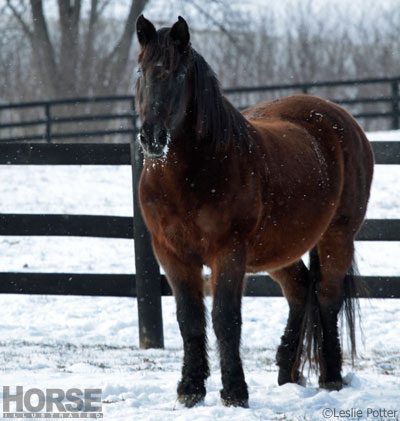
Even if you’re a horse owner who enjoys the winter season, you have to admit that harsh weather makes horseback riding and barn chores more of a challenge. The cold in the far north can be so extreme that it causes your fingers and toes to go numb, turns water troughs into ice boxes, and transforms sleek horses into wooly mammoths. Farther south, where deep mud prevails, you can end up walking right out of your boots; and ice storms routinely paralyze electric grids. The good news is that horses fare well in cold weather.
Many horse owners believe the common misconception that horses get cold in the same weather conditions that make us shiver and pull on the polar fleece. While certain equine individuals may have special requirements because of thin coats or age-related thermostat problems, most horses are comfortable until the temperatures dip below zero degrees Fahrenheit. Even then, many shun their shelters and defiantly stand in the open with their hindquarters to the wind.
For eons, horses survived the coldest weather by seeking a windbreak and huddling together. Then humans came along and intervened with selective breeding and clippers to create the dawn of “The Blanket Age.” Now, many horse owners believe blanketing is necessary. There are blankets of every size, color, weight, weave, insulation and price. You’d never suspect that most horses don’t need more covering from the outdoor elements than their own hair coat.
Aside from horses that have been clipped or those that need winter blankets because they have insufficient coats, many are blanketed by owners who simply want to provide their horses with that extra bit of warmth or protect them from precipitation.
If you decide to cover your horse, you should remove the blanket every day to groom him and check for rub marks. At the very least, readjust the blanket and run your hand beneath it to make sure your horse isn’t sweating. The same principle that motivates human athletes to wear clothes that wick away moisture applies to horses; sweat is the body’s cooling mechanism and can cause a chill if the moisture doesn’t dissipate. If your horse seems overheated, cool him out and cover him with a lighter-weight blanket.
Keep clipping for aesthetics to a minimum in the winter because a long coat and facial, ear and fetlock hair form a barrier that protects the skin from the snow and cold air. If you ride frequently and your horse works up a good sweat, clip his body only in the areas covered by his blanket when he’s at rest.
Protecting Pastures
In cold climates, the ground freezes during the winter. However, that doesn’t mean it’s indestructible. Horses should never be allowed to continually pound around on frozen turf because they will create divots and destroy the root systems of plants. Your pastures will be healthier and hardier in the spring if you keep your horses in corrals or sacrifice areas during the winter. If you only have one pasture, use step-in posts and electric tape to contain your horse to a smaller area, leaving most of the pasture to rest during the winter. Also, mow pastures after the first frost because the snow that will soon follow flattens long grass and weeds and kills what’s underneath.

Hold the Ice
Keeping drinking water in liquid form can be challenging in regions of the country where temperatures regularly stay below freezing. No matter what the season, checking on the water supply should be hard-wired into horse owners’ brains; when temperatures are extreme, free-flowing water is even more crucial. Check your horse’s water every day to be sure it isn’t frozen, which puts him at risk of getting dehydrated. Under no circumstances should horses ever be expected to “just eat snow” in the winter.
Stock tanks can be kept free of ice with water-heating devices, but you will likely need to use extension cords. Young or playful horses love to pull heaters out of the water and are adept at unplugging them. Automatic water systems can solve many problems but must be correctly installed, kept clean, and checked daily. Most importantly, water pipes must run below the frost line in areas where the ground freezes.
Winter Feeding
Feeding high-quality hay is always important, but even more so during the winter when many horses spend increased hours indoors because of the weather. Always buy the best hay available and examine each bale for freshness before feeding it. Even superior stall ventilation cannot ameliorate the chronic breathing problems many horses develop by inhaling moldy and dusty hay spores.

Because horses burn extra calories to stay warm during cold weather, the number of hay feedings should be increased rather than adding more grain. The digestion of hay helps create extra body heat. Youngsters, older horses and hard-keepers in particular should have free-choice access to hay. You can buy more mature, low-calorie hay for horses prone to gaining too much weight.
For horses confined to their stalls on brutally cold days, bran mashes are always welcome treats. Many stable vices caused by spending long winter hours in stalls can be avoided with timely food diversions. You can also help your horse pass the time with more-frequent grooming sessions or barn-aisle lessons such as lowering the head, yielding to pressure or backing up.
Winterizing the Barn
Most horse owners are “weather junkies” and become more so in the winter when storms can complicate riding and turnout schedules, commutes to the barn, and trips to the feed store. Advance preparation is the key to outsmarting the elements. You should anticipate your needs for supplies and stock up before the bad weather arrives.
If you have enough dry storage space, stockpile hay during the summer when it’s least expensive to last you through the winter. Keep a supply of salt for icy walkways, and wrap heat tape around all exposed water pipes prone to freezing.
In very cold barns, check salt blocks when you fill water buckets; your horse’s tongue can stick to a frozen salt block like the proverbial metal playground pole. To prevent this, you can add loose salt to your horse’s grain ration, or provide it free-choice in a separate feed bin.
Avoid the temptation to seal the barn from the bitter cold. Good ventilation is always of the utmost importance to prevent respiratory problems, even in the winter. Moisture buildup on the inside of windows is a sign that you need to open up the barn for more air circulation.
Keeping Yourself Warm
Outdoor apparel companies have improved fabrics and design to keep you comfortable while working in the barn or riding in all but the worst of weather. Fleece hats, lined canvas jackets, wool-blend socks, and insulated boots and gloves are standard wear for barn chores.
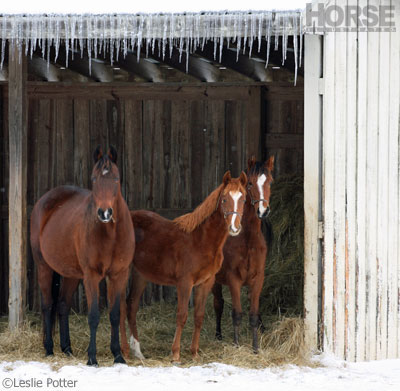 Cold weather riding apparel needs to be warm and flexible. Silk glove liners are perfect for adding that extra layer of warmth to your riding gloves without hampering feel. Down-insulated and polar fleece vests protect against the cold without restricting movement, while insulated boots maintain feeling in your toes. Earmuffs that fasten to your helmet’s chin straps, or a fleece headband that you wear beneath it, will keep your ears warm. Winter riding jackets are insulated (and often waterproof), vented to allow heat to escape, and adjustable at the hips with several snaps that keep the coat from limiting range of motion.
Cold weather riding apparel needs to be warm and flexible. Silk glove liners are perfect for adding that extra layer of warmth to your riding gloves without hampering feel. Down-insulated and polar fleece vests protect against the cold without restricting movement, while insulated boots maintain feeling in your toes. Earmuffs that fasten to your helmet’s chin straps, or a fleece headband that you wear beneath it, will keep your ears warm. Winter riding jackets are insulated (and often waterproof), vented to allow heat to escape, and adjustable at the hips with several snaps that keep the coat from limiting range of motion.
For fingers and toes, routinely the first body parts to stiffen up and lose feeling, chemically activated pocket and boot warmers are indispensable.
Deep Freeze Riding
Some people throw extra hay to their horses and retreat to the house when cold weather moves in; others actually enjoy a snowy ride. If horses can remain warm and mostly dry during a cold ride, they seem to relish getting out, too. Even so, the hardiest riders usually limit exercising their horses in frigid air, many setting a 20-degree Fahrenheit threshold.
Many state park trails are open for winter horseback riding when the footing is firm. In some areas of the country, you may have to share the trails with snowmobiles and dog sleds. You can always try to avoid them by calling the park office to find out when the trails are open and who is sanctioned to use them.
Riding on or near roads is always risky and even more so when the surface is slippery. Not only do horses lose traction and maneuverability, but motor vehicles require more distance to stop. You can improve your horse’s traction by having your farrier put anti-snowball pads between the hoof and shoe: rim pads or sole-covering pads with a convex “ball” in the center will help prevent the build-up of snow in your horse’s hooves. Vaseline smeared in the grooves next to the frog and on the sole help repel snow, but take care to keep it off the frog and bars to prevent the horse from slipping.
For even more traction, your farrier can use borium-tipped nails to anchor your horse’s shoes. These nails have rounded heads that extend slightly beyond the shoe to form “mini-studs.” Be aware that shoes, pads and nails designed to increase traction can be hard on a horse’s legs if left on in the wrong conditions, so they should be considered temporary fixtures.
Don’t let high-tech footwear give you a false sense of confidence, though. Avoid riding across known low spots because a layer of snow often conceals ice, and you may find your horse spraddled out like Bambi on the frozen pond. (You’ll know this is happening when you sense your horse is slowly sinking.) You should also be extra cautious when riding in deep snow because it can obscure ground hazards, such as a downed strand of barbed-wire fence.
Cold weather riding appeals to intrepid individuals everywhere. The show season is over, fewer people are using the trails, the bugs are gone, and horses are energized. For the hale and hearty, winter is just another season to enjoy horses.
Further Reading
The Big Chill
Winter Horse Shoeing
Winter Nutrition: Don’t Forget the Water
Louann Chaudier and her husband live on Restless Spirit Farm in Southern Wisconsin with two Quarter Horses, two wallabies, three barn cats and a Golden Retriever.
This article originally appeared in the November 2009 issue of Horse Illustrated. Click here to subscribe.

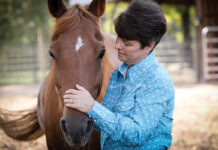
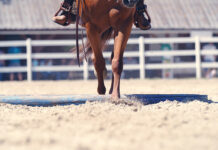
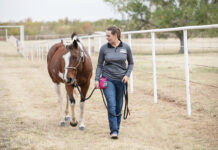
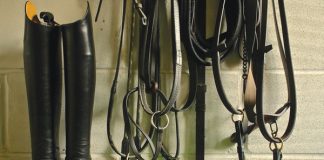

i didnt read this i am just posting this comment so i can get points 😛 i want to buy something that is a lot of points but i dont have enough points. i need points fast
Thank you–this was very helpful,
Great information!
Hey that was way helpful! Espically about the blankets. I’m always parinoid that my horses will freeze in cold weather but its good to be reassured that they won’t!
Horses, unless very old or sick, usually do not need to wear blankets. My horses are outside all day, but do have shelter. The babies stay in at night so they can sleep on a nice warm(er) bed or straw and bedding.
informative
Very useful information. We got snow yesterday and my horses wouldn’t leave their stalls, and they have the option to go outside whenever they want! I blanket my horses because one is older and neither of them grow much of a winter coat.
Always good to keep in mind.
Always more good ideas, and makes a person think about how horses do things in the wilds, or long ago
cool